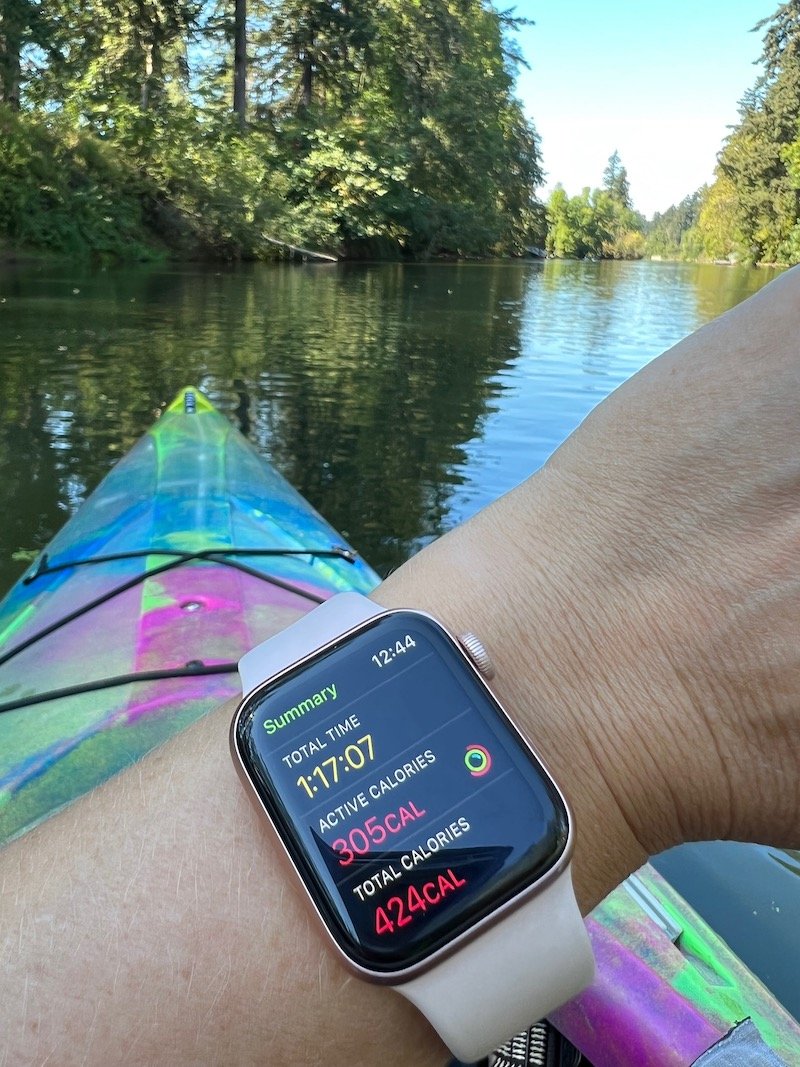Kayaking for exercise: Calorie burn, health benefits & pro tips
If one of your goals is to develop a healthier lifestyle, it’s important to find an activity you enjoy. For some, it’s running. For others, it’s lifting heavy. For us at Flatwater Kayak Club, it’s recreational kayaking.
Moving our bodies is beneficial to our overall health, and to stay in the habit, choosing an activity you want to do rather than feel obligated to do will only make you do the activity more. So, read on to discover the physical benefits of kayaking.
This website may contain affiliate links meaning if you purchase through my link, I’ll receive a small commission at no cost to you.
Is kayaking a good workout?
Yes. Kayaking is a great way to move your body and has an abundance of physical benefits. Kayaking is considered a low-impact, full-body workout providing cardio and strength training that is kind to the joints.
Is kayaking a cardio fitness workout?
Yes. Kayaking is a fantastic cardio workout for your body, and it’s all up to you how intense you get with it. Even on flat water—a slow-moving river or a calm lake—you’ll still get your heart rate up.
It’s typical to burn upwards of 300 calories in an hour on a flatwater kayaking route.
On a recent paddle on the Tualatin River near Portland, Oregon, I paddled for one hour and 17 minutes and burned a total of 424 calories!
According to the CDC, adults need 150 minutes of moderate-intensity physical activity to improve their overall physical health.
Good news for kayakers: Our sport, even recreational kayaking, is a moderate aerobic exercise.
Aerobic exercise strengthens the heart, lowers blood pressure, and bad cholesterol. Incorporating more cardio or endurance exercises—like flatwater kayaking—into your week makes your heart more efficient in moving blood through your body. This means is that your body becomes much more efficient at using oxygen.
Of course, the incredible thing about kayaking is that it’s easy to up the intensity whenever we choose to. Paddling a little faster on calm water will increase the difficulty for your body, or choosing a kayak route where you’re paddling against a slow-to-moderate flat current will increase the challenge (and your heart rate). There’s even the option of incorporating sprints the next time you’re on the water.
Interested in learning more about kayak fitness? Check out our latest post on the future of outdoor adventures with AI technology and learn about the time I did a 12-week walking challenge to improve cardio health.
A high-intensity paddling sprint workout to try on your next kayak trip:
30 seconds of paddling as fast as you can
10 seconds of rest
Repeat 6 times, then take a longer rest
With that simple format for a kayaking workout, you can adapt to your fitness level as you need—you can paddle sprint for longer, or take longer rests in between.
The more time you spend in your kayak, the stronger you’ll become, and the more endurance you’ll have. You’ll start to notice that you can paddle for longer without feeling fatigued. And this increased steady level of energy will easily carry you throughout the day.
Does kayaking build muscle?
Recreational kayaking will improve your fitness strength and build muscle. It’s a full-body workout that works your arms, legs, back, shoulders, and core muscles.
The paddling motion—the push and pull through the water—will strengthen your back, shoulders, arms, and core.
And while it may feel like your legs aren’t getting much action since you’re sitting, they’re working isometrically.
This means that small muscle contractions are happening in your core, your glutes, and the length of your legs to keep you balanced while maneuvering your kayak.
Developing stronger muscles will not only make paddling on the water easier, but building strength can also positively impact your bone density, improve balance, lower blood sugar levels, and help you burn more calories at rest.
I walked 400 miles in 12 weeks to improve kayaking fitness, overall strength, and cardio health. Tap the image to learn more.
More information on recreational kayaking from our free Flatwater Kayak Club resource library:
Everything you need to know about flatwater kayaking
Do you need a kayak permit in the Pacific Northwest states (Oregon, Washington, Idaho)?
Learn to how to choose the best kayak for you
What to wear kayaking in the Pacific Northwest
Kayak racks: what buyers need to know
Canoe vs kayak: differences, pros & cons










![Floating home cabin for rent [REVIEW]](https://images.squarespace-cdn.com/content/v1/62c5c6be9225615a8d0231a9/5288183e-d43e-418c-9fa1-095bc59b4e3f/FloatingHome-Rental-Oregon-OruInlet-Kayaking-FlatwaterKayakClub.jpeg)
Paddling across the glacier-clear waters of Eastern Oregon in a clear-bottom kayak under a sky full of stars is an unforgettable adventure.